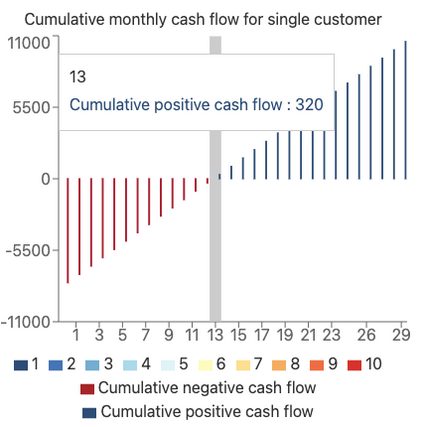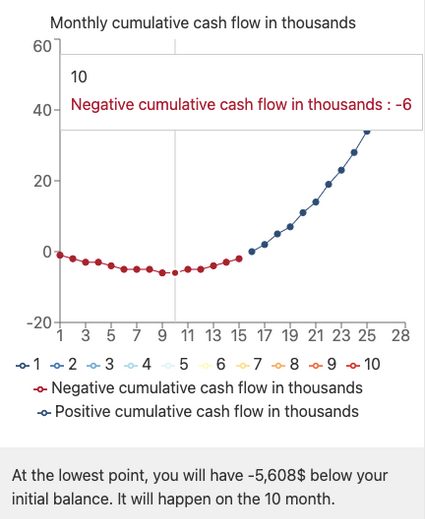SaaS Metrics Calculator
- What is SaaS and which are the key SaaS metrics every business owner should know?
- What is lifetime value (LTV) and how to calculate it?
- What is CAC (cost of acquiring a customer)?
- What is CAC recovery or CAC payback time?
- What is the LTV CAC ratio?
- How to calculate customer profitability in a SaaS business
- How to use our SaaS metrics calculator
- FAQ
The incredible SaaS metrics calculator is here to help you plan your SaaS business model. It will show you how to calculate the most important SaaS metrics, such as:
- LTV (lifetime value);
- CAC (cost for acquiring a customer);
- LTV to CAC ratio; and
- Cumulative cash flow for multiple customers
We will also include examples in every key SaaS metric for you to grasp the concept even more.
What is SaaS and which are the key SaaS metrics every business owner should know?
SaaS stands for software as a service, and it is a tech-related business category where companies offer a software product as a service. It usually follows a subscription model in which the client pays a monthly/yearly fee for having access to the software platform.
Before we start checking the key SaaS metrics, let's talk a bit more about the business nuances:
- Clients have a lifetime (lifetime value or LTV). They start using the service, and one day they will stop using it (some clients sooner, others later).
- There is a cost for servicing the clients (cost of goods sold) which can include application hosting, website development, etc.
- There is a marketing expense and also a sales expense that the company puts upfront to acquire the clients: (customer acquisition cost - CAC).
- During the lifetime of the client-business relationship, there is a point where the company reaches the break-even point where the revenue made from the client surpasses his acquisition cost.
- When starting to acquire multiple customers, the company will experience a significant drawdown of their initial balance because of having negative cash flows.
Now we have the framework, we can mention the SaaS metrics that you can use for measuring business success:
- SaaS Lifetime value (LTV);
- CAC (cost of acquiring a customer);
- CAC payback;
- CAC to LTV ratio; and
- Customer profitability.
Keep reading as we will explain how to use each metric for your SaaS business model. First, we will start with the single-user metrics.
What is lifetime value (LTV) and how to calculate it?
Lifetime value or LTV refers to the amount of money that a company receives from the average client during the time the client remains a client.
SaaS companies refer to ARPA (average revenue per account) and churn rate (more about it in the churn rate calculator) as the payments made per client and the rate they end their contract.
However, ARPA does not represent the money the company profits. We have to subtract the cost of goods sold (COGS):
Gross revenue = Revenues - COGS
Gross revenue represents the money the company receives from a client. Still, it is not net income because there are other expenses like the marketing one we still have to subtract. Consequently:
Gross margin = (Gross revenue / Revenues) × 100%
Gross margin represents the revenue remaining percentage after subtracting all COGS. Therefore:
LTV = ARPA × Gross margin / Churn rate
Our SaaS metrics calculator considers monthly ARPA for its operations.
What is CAC (cost of acquiring a customer)?
In SaaS, CAC represents the money the company puts upfront for getting customers. It can be divided into the next two items:
- Selling expenses: Payments to your sales representatives; and
- Marketing expenses: Money invested in internet marketing. Check our online marketing conversion calculator to learn more.
In SaaS, the formula relates both expenses to the number of clients the company acquires:
CAC = (Selling expenses + Marketing expenses) / # of new clients acquired
What is CAC recovery or CAC payback time?
CAC recovery or time to payback CAC refers to the time that will pass until the money charged to the client (subtracting COGS) reaches the same value spent on acquiring the client. Let's see the formula:
CAC payback = CAC / (ARPA × Gross margin)
Note ARPA is a per-user monthly value. Thus, the denominator refers to monthly gross profit. By dividing CAC by the monthly gross profit, we obtain the time needed for recovering what we invested in acquiring the average customer.
During CAC recovery time, the company will be cash flow negative. It indicates how much time the company needs to survive without profits. Hence, it will require financing which can come from equity or debt.
The recommendation is to keep CAC payback time below 12 months so investors can see some return on their investment.
Assume the following example data:
CAC = 8000 USD
ARPA = 800 USD / month
Gross margin = 80%
Churn rate = 2%
Putting this data into our SaaS metrics calculator, we get the result of CAC payback = 12.5 months, meaning we will be cash-flow positive by the end of the 13 months.

What is the LTV CAC ratio?
The LTV to CAC ratio represents the value of a customer compared to the cost of acquiring him. The formula is:
LTV to CAC = LTV / CAC
So, what is a good LTV to CAC ratio? SaaS experts recommend this ratio be above 3, indicating that during the client's lifetime, the revenues generated are much larger than the cost of acquiring him.
Here are some recommendations for improving LTV to CAC ratio:
- Increase ARPA or gross margin.
- Reduce the churn rate.
- Reduce CAC in your SaaS.
- Indirectly, if we focus on improving our return on advertisement expense, ROAS, we will reduce CAC, thus, improving LTV to CAC ratio.
How to calculate customer profitability in a SaaS business
The last ratio in our SaaS metrics calculator for a single client is customer profitability (CP):
CP = LTV - CAC
If you acquire customers and retain them long enough (low churn rate / high LTV), eventually that account will provide enough revenue for profitability.
How to use our SaaS metrics calculator
So, let's assume you run a company that sells a team management app. After a few months of having started, you find out:
- CAC = 100 USD;
- ARPA = 20 USD/month;
- Gross margin = 80%; and
- Churn rate = 2%.
Then, you decide to put such values in our SaaS metrics calculator, and you obtain.
LTV = (20 USD × 80% / 2%) = 800 USD
LTV to CAC ratio = 800 USD / 100 USD = 8
CAC recovery = 100 USD / (20 USD/month × 80%) = 6.25 months
Customer profitability = 800 USD - 100 USD = 700 USD
Furthermore, we know we usually do not start with single customers. We probably acquire 10 in the first month, then 12 the next one, then 14, and so on. But also, we start losing customers (churn rate).
In our tool, the variables:
1st month - Number of new customers
Monthly growth rate for new customers
...represent how many customers we added the first month and how many more we are adding each month. Considering our example in the paragraph above, we have:
Month 1 | Month 2 | Month 3 | Month 4 | Month 5 | Month 6 | |
|---|---|---|---|---|---|---|
Number of new customers added | 10 | 12 | 14 | 16 | 18 | 20 |
No of customers lost to churn | 0 | 0 | 0 | -1 | -1 | -1 |
Total customers (TC) | 10 | 22 | 36 | 51 | 68 | 87 |
Total CAC | -1000 | -1200 | -1400 | -1600 | -1800 | -2000 |
Note that spend more and more money on acquiring more customers each time. Now, if we consider that all customers pay their subscription bill each month: ARPU, and to that amount, we subtract COGS and CAC, and we have a monthly cash flow (see the row in dark green).
Month 1 | Month 2 | Month 3 | Month 4 | Month 5 | … | Month 16 | |
|---|---|---|---|---|---|---|---|
ARPU × TC × gross margin | 160 | 352 | 576 | 816 | 1088 | … | 5712 |
Total CAC | -1000 | -1200 | -1400 | -1600 | -1800 | … | -4000 |
Monthly cash flow | -840 | -848 | -824 | -784 | -712 | … | 1712 |
Cumulative cash flow | -840 | -1688 | -2512 | -3296 | -4008 | … | 64 |
Consequently, we experience losses for several months and accumulate a negative balance (see the row in crimson color), a period where we have to be prepared if we don't want to go bankrupt.
However, if you acquire the correct number of customers, and they stay for long enough plus an adequate gross margin, eventually you become profitable.

Our SaaS metrics calculator also indicates the lowest balance you will have and which month it will occur so you can prepare forward.
FAQ
What are the most famous SaaS metrics?
CEOs consider these key SaaS metrics as the best:
- LTV: Lifetime value represents all the revenue from a client during the business relationship.
- LTV to CAC ratio: Indicates how much money the company makes from the client compared to the amount invested in acquiring them.
- CAC payback: Represents the time the company requires to break even after investing in acquiring the customer.
- Customer profitability: Indicates how much money the company profits from a client after all expenses.
What is a good LTV to CAC ratio?
A great LTV to CAC ratio is over 3. It indicates that the total revenue generated from a particular account is three times its acquisition cost. Of course, the bigger, the better. For example, you can increase your LTV to CAC ratio by reducing your churn rate.
What is churn rate?
The churn rate indicates how many of your new clients are leaving given a specific period. You can calculate it as follows:
- Divide the customers lost over a period by the total customers at the beginning of the same period. The result has to be multiplied by 100 to get a percentage.
How do I calculate CAC payback?
Here there are the steps to calculate the CAC recovery time:
- Determine your cost of acquiring customers (CAC), average revenue per account (ARPA), and the gross margin of your services. We recommend you use monthly ARPA.
- Divide CAC by the product of ARPA and gross margin.
- The resulting number indicates the period in months you need to reach breakeven.